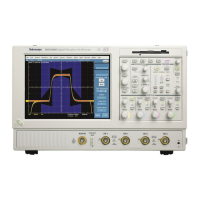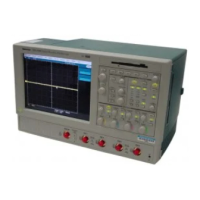TDS5000B Online Programmer Guide
-- 8 --
Messages
A command message is a command or query name followed by any
information the instrument needs to execute the command or query.
Command messages may contain five element types, defined in the
following table.
Command Message Elements
Symbol Meaning
<Header> This is the basic command name. If the
header ends with a question mark, the
command is a query. The header may begin
with a colon (:) character. If the command is
concatenated with other commands, the
beginning colon is required. Never use the
beginning colon with command headers
beginning with a star (*).
<Mnemonic> This is a headersubfunction. Some
command headers have only one mnemonic.
If a command header has multiple
mnemonics, a colon (:) character always
separates them from each other.
<Argument>
This is a quantity, quality, restriction, or limit
associated with the header. Some
commands have no arguments while others
have multiple arguments. A <space>
separates arguments from the header. A
<comma> separates arguments from each
other.
<Comma>
A single comma is used between arguments
of multiple--argument commands. Optionally,
there may be white space characters before
and after the comma.
<Space> A white space character is used between a
command header and the related argument.
Optionally, a white space may consist of
multiple white space characters.
Commands
Commands cause the instrument to perform a specific function or
change one of the settings. Commands have the structure:
[:]<Header>[<Space><Argument>[<Comma>
<Argument>]...]
A command header consists of one or more mnemonics arranged in a
hierarchical or tree structure. The first mnemonic is the base or root of
the tree and each subsequent mnemonic is a level or branch off the pre-
vious one. Commands at a higher level in the tree may affect those at a
lower level. The leading colon (:) always returns you to the base of the
command tree.

